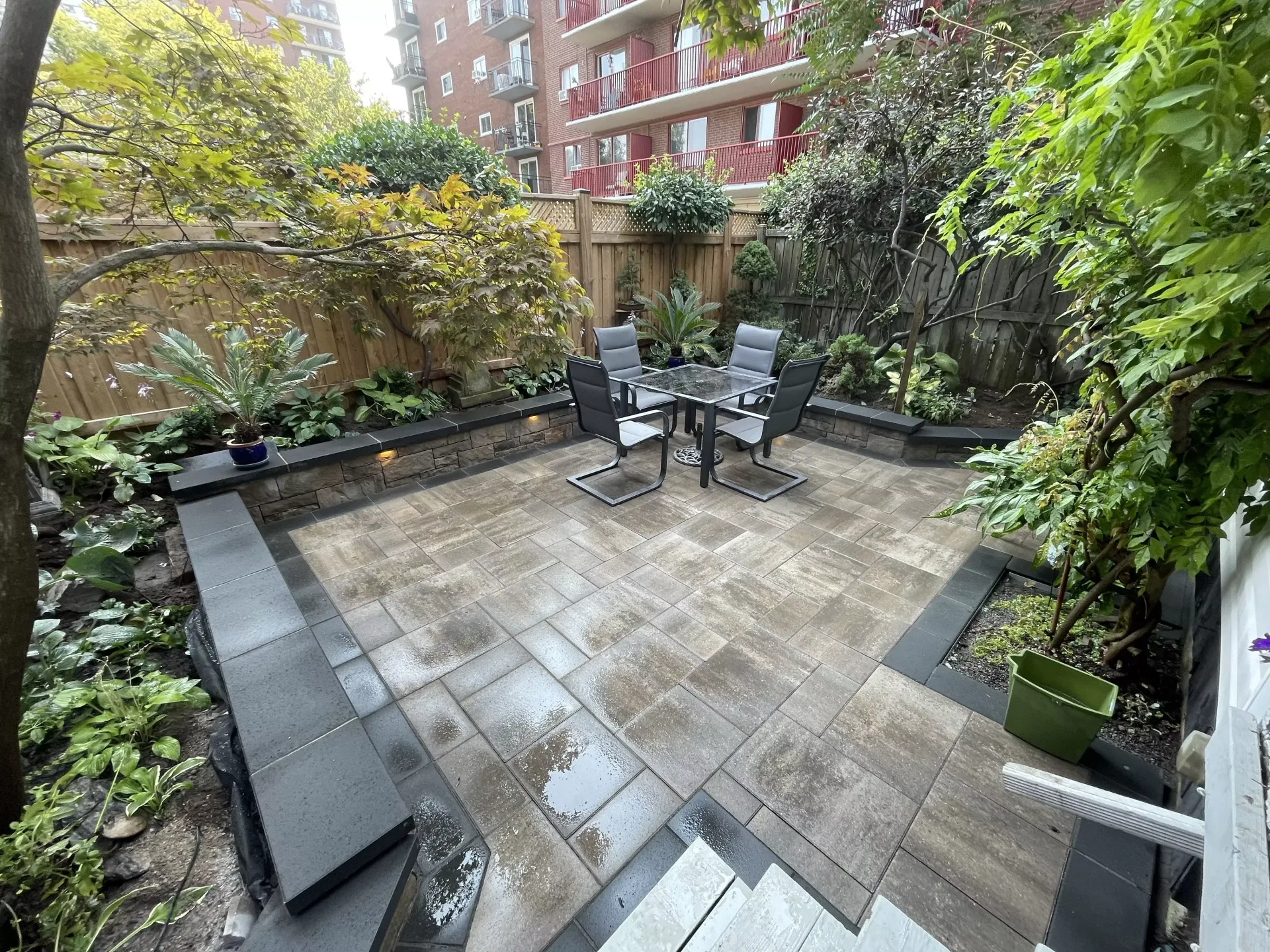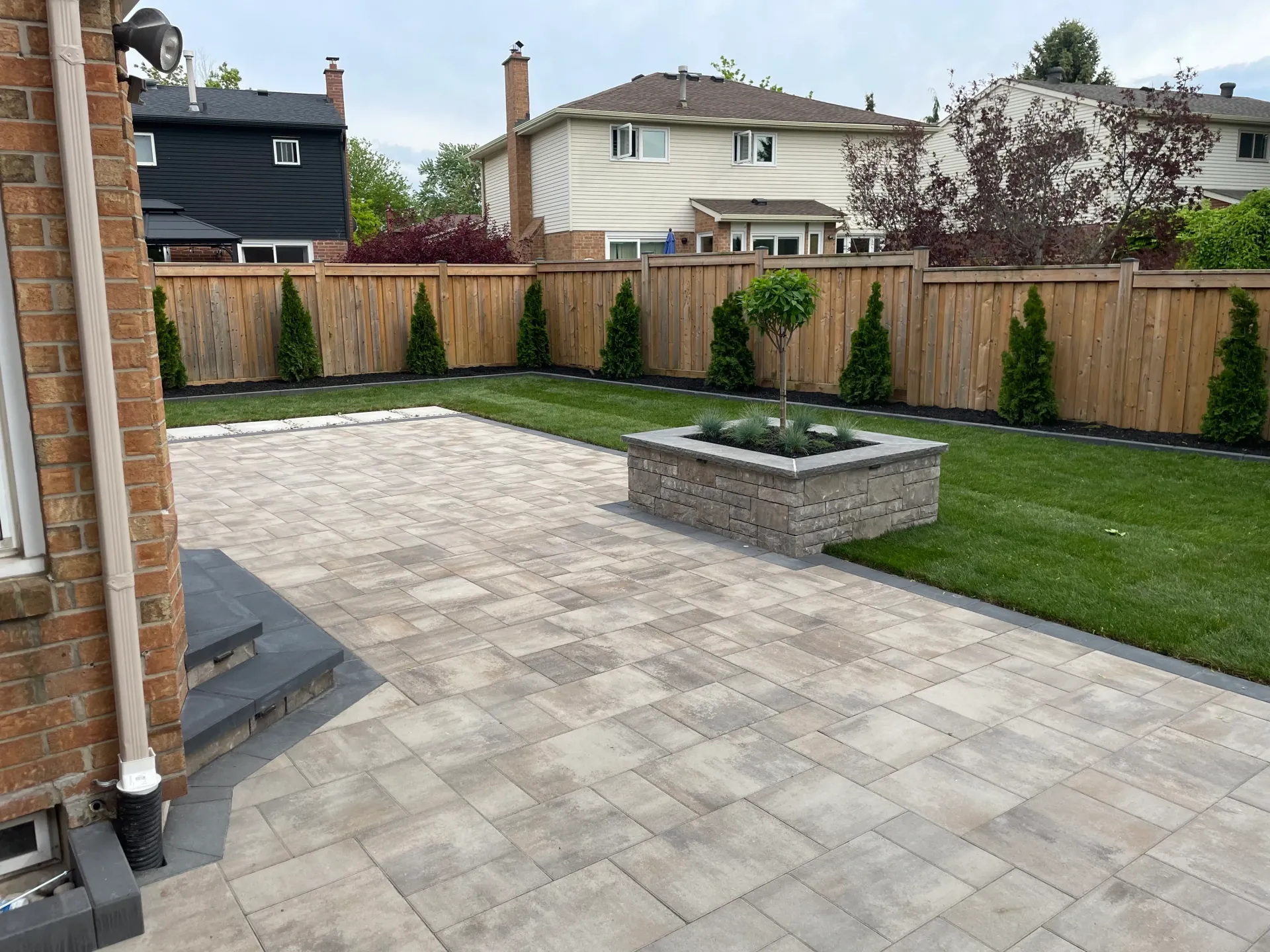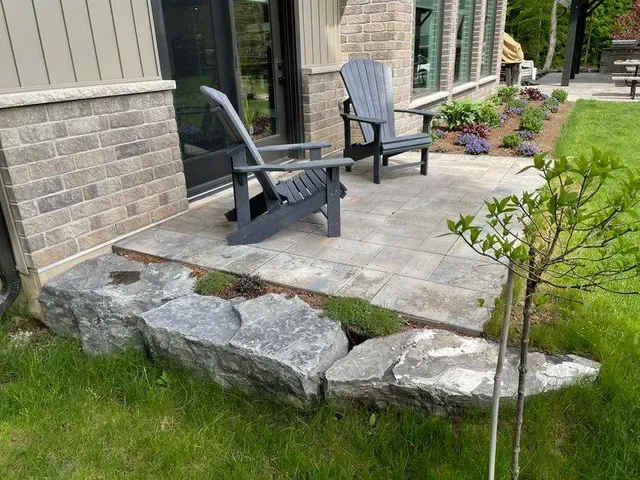Average Patio Cost
How Much Does a New Patio Cost per Square Foot?

Investing in an outdoor living space can dramatically enhance your home’s functionality, curb appeal, and resale value. Among the most popular hardscape upgrades, a patio offers a versatile area for dining, entertaining, and relaxation. But before you break ground, it’s crucial to understand the factors that influence patio cost per square foot, contributing to the total cost of your project. In this guide, we’ll walk through material choices, labor and site‐preparation expenses, additional considerations (like drainage and permits), and pro tips for managing your budget—so you can plan with confidence.
Understanding Patio Cost per Square Foot Matters
When shopping for a new patio, contractors often quote prices in terms of dollars per square foot. This metric helps you:
- -Compare material and labor options side-by-side.
- -Scale your budget as you adjust patio size.
- -Set realistic expectations for design features and finishes.
Rather than a vague lump-sum estimate, thinking in per-square-foot terms empowers you to make informed decisions about materials, layout complexity and design complexity , and extras like lighting or seating walls, considering the many factors that influence the overall cost.
Introduction to Cost Calculation
When planning a paver patio project, understanding the various factors that affect the overall cost is essential. The cost of a paver patio typically ranges from $10 to $24 per square foot, depending on the materials, design complexity, and labor costs. To get an accurate estimate, consider the size of the patio, the type of paver material, and the complexity of the design. For instance, a DIY paver patio project can be more cost-effective, but it may require additional labor and materials. By breaking down the costs per square foot, you can better manage your budget and make informed decisions about your patio project.
Key Factors That Drive Patio Cost per Square Foot
1. Material Selection
Patio materials, including various stone types, vary widely in appearance, durability, and price. Here’s a snapshot of common options:
Concrete pavers tend to be the most budget-friendly, averaging roughly $10–$25 per square foot installed, representing the lower end of the pricing spectrum. Their uniform shapes and interlocking design make them relatively quick to lay and easy to replace if damaged. Natural stone options—such as flagstone, bluestone, or limestone—command higher prices ($20–$40 per square foot) due to their classification as premium materials. due to quarrying, irregular shapes, and more labor-intensive installation, making them high end materials. Exposed aggregate or stamped concrete can fall in the mid-range ($12–$30 per square foot), offering customizable textures and colors at a lower cost than natural stone.
2. Site Preparation and Excavation
Before any patio can be laid, the project site must be cleared of vegetation, debris, and, in some cases, existing structures, depending on the site conditions. Excavation depth depends on frost-line requirements in Ontario: typically 8–12 inches. Proper grading ensures drainage away from your home’s foundation and prevents puddling on the patio surface, among other factors that affect installation . This groundwork, which can add $3–$8 per square foot, is non-negotiable—skimping here risks shifting pavers, cracking concrete, or uneven settling over time.
3. Base Material and Installation
Once the site is excavated, a sturdy base of crushed stone or gravel must be installed and compacted. A typical base for paver patio installation consists of a 4–6 inch layer of ¾-inch crushed limestone or similar aggregate. You’ll also need a layer of bedding sand for pavers or a concrete slab for cast-in-place projects. Base-related costs generally range from $2–$5 per square foot, depending on material type, depth, and material availability.
4. Labor Costs and Complexity
Labor is often the single largest variable in patio pricing. Experienced installers charge anywhere from $8–$20 per square foot, depending on the following:
- -Pattern complexity: Herringbone, basket weave, and intricate patterns take longer to install than simple running bonds.
- -Site access: A backyard that’s hard to reach or has tight spaces may require additional labor to haul materials.
- -Slope and grading: Terraced or multi-level patios involve retaining walls and more precise leveling.
5. Finishing Touches and Accessories
Your per-square-foot figure should account for extras that transform a basic hardscape into an inviting outdoor room, including the cost of removing or replacing other materials. These might include:
- -Sealing and joint stabilization to protect pavers from stains and freeze-thaw damage.
- -Border treatments such as contrasting stone, metal edging, or planter walls.
- -Integrated lighting, which can add $10–$30 per linear foot but dramatically enhances usability after dark.
While accessory costs are often quoted separately, they can effectively raise your average cost per square foot by 10–20 percent when amortized over the entire patio area.
Outdoor Space Design
A well-designed outdoor space can significantly enhance the aesthetic appeal of a property. When designing an outdoor space, it’s essential to consider the patio size and layout, as well as the type of paver material and other features such as fire pits or outdoor kitchens. The right paver material can make a significant difference in the overall look and feel of the patio. For instance, concrete pavers are a popular choice for outdoor patios due to their durability and low maintenance. Natural stone, such as flagstone or brick pavers, can also add a touch of elegance to the patio. By carefully selecting the right materials and design elements, you can create an inviting and functional outdoor space.
Patio Installation Process
The patio installation process involves several steps, including site preparation, base preparation, and paver installation. Proper base preparation, often requiring professional installation, is a crucial step in ensuring the longevity of the patio. The base material should be well-compacted crushed stone, with a minimum depth of 7-9 inches. Compacting the base material in “lifts” (3-4 inches at a time) is essential to prevent shifting or sinking of the patio. Additionally, proper drainage is critical to prevent water damage and ensure the patio remains safe and functional. By following these steps, you can ensure a durable and long-lasting patio installation.
Real-World Cost Breakdown Examples
To illustrate how these factors combine, let’s examine a few examples of hypothetical patios:
- -Basic Concrete Paver Patio (300 sq ft)
- Excavation & grading: $1,200 ($4/sq ft)
- Gravel base & sand bedding: $900 ($3/sq ft)
- Pavers & labor: $6,000 ($20/sq ft)
- Sealing & edge restraints: $600 ($2/sq ft) Total: $8,700 → $29/sq ft
- -Flagstone Patio with Seating Wall (500 sq ft)
- Excavation & grade prep: $2,500 ($5/sq ft)
- Base materials: $2,000 ($4/sq ft)
- Stone & intricate pattern labor: $17,500 ($35/sq ft)
- Seating wall (40 ft @ $50/ft): $2,000
- Lighting & sealant: $2,000 Total: $26,000 → $52/sq ft
These scenarios underscore how material choice and design features drive the per-square-foot cost. A simple paver patio may cost under $30 per square foot, whereas high-end natural stone installations can exceed $50 per square foot once all elements are factored in.
Additional Cost Considerations
Drainage Solutions
Improper drainage can jeopardize both your new patio and your home’s foundation. French drains, swales, or channel drains may be necessary if water doesn’t naturally flow away from the patio surface. Budget $5–$15 per square foot for professional drainage installation.
Permits and Local Regulations
Many municipalities in Ontario require permits for hardscape structures exceeding a certain footprint (often around 15 sq m). Permit fees are usually modest ($100–$500) but failing to obtain approval can result in costly fines or forced removal.
Seasonal Timing
While patios can be installed throughout much of the year, contractors are busiest from late spring through early fall. Scheduling off-peak may yield slight discounts, but cold-weather installations require special additives in concrete and can risk slower curing times.
Patio Size and Layout
The size and layout of the patio play a significant role in determining the overall cost. While larger patios require more materials and labor, a smaller patio can still provide essential space for outdoor living. A well-designed patio can include features such as a fire pit, outdoor kitchen, or hot tub, which can enhance the overall aesthetic appeal and functionality of the outdoor space. When designing a patio, it’s essential to consider the yard’s terrain, as well as the location of other outdoor features such as a pergola or short walkway. By carefully planning the size and layout, you can create a beautiful and functional outdoor area that meets your needs.
Tips to Manage Your Patio Budget
- -Optimize Patio Size: A larger patio offers more living space but increases costs linearly. Consider whether you’ll truly use every square foot. A well-designed 200 sq ft area can feel more spacious if it incorporates open sightlines, planters, or contrasting materials.
- -Mix and Match Materials: Combining budget-friendly pavers for the main area with a natural stone border can deliver visual impact without the premium price tag across the entire surface.
- -Prioritize Essentials First: Ensure the excavation, base, and drainage are done correctly before adding decorative elements. You can phase in lighting, seating, or built-in planters over time without jeopardizing the patio’s integrity.
- -Get Multiple Quotes: Don’t settle for the first estimate, as costs can vary based on several factors. Compare at least three qualified contractors, checking for consistent line items. A significantly low bid may cut corners; a sky-high bid could include unneeded extras.
DIY vs. Professional Installation
Enthusiastic homeowners sometimes consider tackling a diy paver patio installation themselves. While DIY can save labor costs, it also introduces risks:
- -Time Investment: Excavating, grading, and compacting base materials is physically demanding and time-consuming.
- -Precision Requirements: Even minor grading errors can lead to pooling or uneven settling.
- -Warranty & Liability: Professional installers often provide warranties on labor and materials, and they carry insurance in case of onsite accidents.
Unless you have hardscape experience and the right equipment (plate compactor, masonry saw, etc.), hiring a reputable contractor typically ensures a high-quality, long-lasting result.
Benefits of Paver Patios
Paver patios offer several benefits, including low maintenance, durability, and aesthetic appeal. They can be designed to fit various budgets and can be made from a range of materials, including concrete pavers, natural stone, and brick pavers. Paver patios can also increase the value of a property and provide a comfortable outdoor space for relaxation and entertainment. With proper base preparation and drainage, a paver patio can last for many years, making it a cost-effective option for homeowners. Additionally, paver patios can be designed to include additional features such as polymeric sand, which can help prevent weed growth and improve drainage. By choosing a paver patio, you can enjoy a beautiful and functional outdoor space for years to come.
How to Choose the Right Patio Contractor
Look for companies that:
- -Specialize in both material expertise and site engineering.
- -Provide detailed, itemized bids showing per-square-foot breakdowns.
- -Carry proof of insurance, licensing, and verifiable customer testimonials.
- -Offer warranties on both materials and workmanship.
A skilled contractor will discuss your desired style, recommend suitable materials for Ontario’s freeze-thaw cycle, and explain how they’ll address site-specific challenges like soil conditions or slope, ensuring a well-executed patio design.
Return on Investment (ROI) Considerations
A professionally installed patio typically recoups 70–80 percent of its patio cost at resale, depending on market conditions and buyer preferences. In areas where outdoor living is highly valued, a well-designed patio can differentiate your property and command a premium, enhancing the appeal of your outdoor spaces. Even if you don’t plan to sell soon, enhanced enjoyment of your outdoor space and the ability to host friends and family often make the investment worthwhile.
Final Thoughts
Estimating the paver patio cost in dollars per square foot helps you balance design aspirations with budget realities. From basic concrete pavers at under $30 per square foot to bespoke natural stone terraces exceeding $50 per square foot, the choices are vast—and each comes with its own benefits, maintenance needs, and aesthetic impact, influenced by the patio's size. By understanding excavation, base preparation, labor, materials, and finishing touches, you can plan an outdoor space that meets your lifestyle without unexpected surprises.
When you’re ready to explore your patio options, get in touch with Wilson Hardscape for a free consultation and detailed cost estimate tailored to your property’s specific conditions and your design goals. We’ll help you create a durable, beautiful patio that stands the test of time—and the Ontario seasons.




